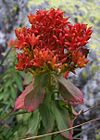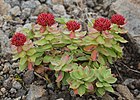Note: This is a project under development. The articles on this wiki are just being initiated and broadly incomplete. You can Help creating new pages.
Difference between revisions of "Rhodiola rosea - Golden root"
(→Common names) |
|||
| Line 1: | Line 1: | ||
[[File:Rhodiola rosea perennial.JPG|thumb|right|''Rhodiola rosea'']] | [[File:Rhodiola rosea perennial.JPG|thumb|right|''Rhodiola rosea'']] | ||
| − | |||
'''Rhodiola rosea''' is a perennial flowering plant in the family Crassulaceae. It grows in cold regions of the world, including much of the Arctic, the mountains of Central Asia, scattered in eastern North America from Baffin Island to the mountains of North Carolina, and mountainous parts of Europe, such as the Alps, Pyrenees, Sudetes and Carpathian Mountains, Scandinavia, Iceland, Great Britain and Ireland. | '''Rhodiola rosea''' is a perennial flowering plant in the family Crassulaceae. It grows in cold regions of the world, including much of the Arctic, the mountains of Central Asia, scattered in eastern North America from Baffin Island to the mountains of North Carolina, and mountainous parts of Europe, such as the Alps, Pyrenees, Sudetes and Carpathian Mountains, Scandinavia, Iceland, Great Britain and Ireland. | ||
==Uses== | ==Uses== | ||
| − | {{Uses| | + | {{Uses|Stomach aches}}, {{Uses|Intestinal discomfort}}, {{Uses|Tuberculosis}}, {{Uses| Depression}}, {{Uses|Anxiety}}, {{Uses|Brain fog}}, {{Uses|Sleep deprivation}}, {{Uses|Diarrhea}}, {{Uses|Adrenal fatigue}} |
==Parts Used== | ==Parts Used== | ||
| Line 36: | Line 35: | ||
==Identification== | ==Identification== | ||
===Leaf=== | ===Leaf=== | ||
| − | {{Leaf|Simple|Alternate|the leaves are simple i.e. | + | {{Leaf|Simple|Alternate|the leaves are simple i.e.lobed or unlobed but not separated into leaflets}}<ref name="Leaf"/> |
===Flower=== | ===Flower=== | ||
| Line 57: | Line 56: | ||
==Commonly seen growing in areas== | ==Commonly seen growing in areas== | ||
| − | {{Commonly seen|Crevices of mountain rocks}}, {{Commonly seen| | + | {{Commonly seen|Crevices of mountain rocks}}, {{Commonly seen|At sea cliffs}}, {{Commonly seen|Borders of forests and fields}}. |
==Photo Gallery== | ==Photo Gallery== | ||
Revision as of 18:06, 15 January 2019
Rhodiola rosea is a perennial flowering plant in the family Crassulaceae. It grows in cold regions of the world, including much of the Arctic, the mountains of Central Asia, scattered in eastern North America from Baffin Island to the mountains of North Carolina, and mountainous parts of Europe, such as the Alps, Pyrenees, Sudetes and Carpathian Mountains, Scandinavia, Iceland, Great Britain and Ireland.
Contents
- 1 Uses
- 2 Parts Used
- 3 Chemical Composition
- 4 Common names
- 5 Properties
- 6 Habit
- 7 Identification
- 8 List of Ayurvedic medicine in which the herb is used
- 9 Where to get the saplings
- 10 Mode of Propagation
- 11 How to plant/cultivate
- 12 Commonly seen growing in areas
- 13 Photo Gallery
- 14 References
- 15 External Links
Uses
Stomach aches, Intestinal discomfort, Tuberculosis, Depression, Anxiety, Brain fog, Sleep deprivation, Diarrhea, Adrenal fatigue
Parts Used
Chemical Composition
Phenylpropanoids, rosavin, rosin, rosarin (specific to R. rosea, Phenylethanol derivatives, salidroside (rhodioloside), tyrosol[1]
Common names
| Language | Common name |
|---|---|
| Kannada | |
| Hindi | |
| Malayalam | |
| Tamil | |
| Telugu | |
| Marathi | NA |
| Gujarathi | NA |
| Punjabi | NA |
| Kashmiri | NA |
| Sanskrit | |
| English | Golden root |
Properties
Reference: Dravya - Substance, Rasa - Taste, Guna - Qualities, Veerya - Potency, Vipaka - Post-digesion effect, Karma - Pharmacological activity, Prabhava - Therepeutics.
Dravya
Rasa
Tikta (Bitter), Kashaya (Astringent)
Guna
Laghu (Light), Ruksha (Dry), Tikshna (Sharp)
Veerya
Ushna (Hot)
Vipaka
Katu (Pungent)
Karma
Kapha, Vata
Prabhava
Habit
Identification
Leaf
| Kind | Shape | Feature |
|---|---|---|
| Simple | Alternate | the leaves are simple i.e.lobed or unlobed but not separated into leaflets |
Flower
| Type | Size | Color and composition | Stamen | More information |
|---|---|---|---|---|
| Unisexual | 2-4cm long | green to brown | 8 | the flower is radially symmetrical |
Fruit
| Type | Size | Mass | Appearance | Seeds | More information |
|---|---|---|---|---|---|
| Simple | 4–9 mm | the fruit is dry and splits open when ripe | many | {{{6}}} |
Other features
List of Ayurvedic medicine in which the herb is used
- Vishatinduka Taila as root juice extract
Where to get the saplings
Mode of Propagation
How to plant/cultivate
Prefers a fertile well drained open loam in a sunny position[3]
Commonly seen growing in areas
Crevices of mountain rocks, At sea cliffs, Borders of forests and fields.
Photo Gallery
References
External Links
- Ayurvedic Herbs known to be helpful to treat Stomach aches
- Ayurvedic Herbs known to be helpful to treat Intestinal discomfort
- Ayurvedic Herbs known to be helpful to treat Tuberculosis
- Ayurvedic Herbs known to be helpful to treat Depression
- Ayurvedic Herbs known to be helpful to treat Anxiety
- Ayurvedic Herbs known to be helpful to treat Brain fog
- Ayurvedic Herbs known to be helpful to treat Sleep deprivation
- Ayurvedic Herbs known to be helpful to treat Diarrhea
- Ayurvedic Herbs known to be helpful to treat Adrenal fatigue
- Herbs with Dried Folaige used in medicine
- Herbs with Whole herb used in medicine
- Herbs with common name in English
- Habit - Herb
- Index of Plants which can be propagated by Seeds
- Herbs that are commonly seen in the region of Crevices of mountain rocks
- Herbs that are commonly seen in the region of At sea cliffs
- Herbs that are commonly seen in the region of Borders of forests and fields
- Herbs








